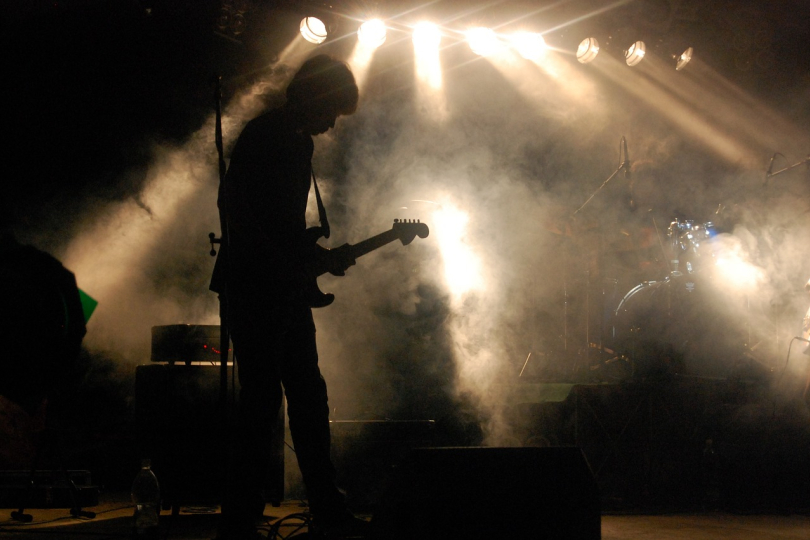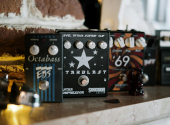
The Guitarist's Survival Guide: How Not to Sound Like a Hot Mess on Stage
As a guitarist, it's hard to beat the thrill of performing live onstage. The adrenaline rush from interacting with a live audience, that old familiar cocktail of blood, sweat, and tears – until you notice no one can hear you, trip over a cable, knock over your amp, and realise you're not quite the rock god you thought you were. Whether you're about to play your third sold-out show at Madison Square Garden or preparing for your first gig in your local pub, getting a great live sound is crucial. In this guide, I'll cover some practical tips on stagecraft, EQ, pedalboard preparation, and sound checking I have picked up from more than a decade of playing live.
1. Earplugs – a no-brainer
The first of some unsexy tips, but arguably the most crucial you’ll ever receive in your music career: invest in a pair of musicians' earplugs. They’ll reduce sound to a manageable level while actually enhancing your listening experience. Best of all, they’ll keep your hearing intact. Don’t be a ninny – protect those ears!
2. Loop Your Cable – What is this? Amateur hour?!
Picture this: you’re deep into your set, the crowd is loving it, and then… your sound cuts out. You look down and see that you’ve stepped on your cable, unplugged yourself, and are now awkwardly fumbling around to fix the issue. I’ve seen this happen many times – hell, it’s happened to me.
Okay, maybe this doesn’t technically fall under the purview of “getting a great live sound”, but if you’re not plugged in, the world isn’t going to be picking up what you’re putting down, so to speak.
One simple way to prevent this from happening is to loop your cable through the strap of your guitar. This keeps the cable secure and reduces the chance of it yanking out while you’re moving around. It’s a basic trick, but one that can save you from those painful moments of silence and confusion on stage.
3. Pedalboard Preparedness – Bring a Backup
Another less-than-sexy tip, but as Hendrix himself always said – “there’s nothing truly groovier than due diligence”!* Your pedalboard is essential to crafting your tone, but it can also be the source of unwanted surprises during a gig. There’s a particular flavour to the stress of looking out at a large audience, then glancing down at a pedalboard with 40 different connections and realising one of them has malfunctioned (perhaps isn’t plugged in properly?) while knowing you have only 20 seconds to fix it.
Do yourself a favour:
Spare patch cables and a backup power supply should be non-negotiable additions to your gear bag. You’ll feel like you have Sherlock Holmes-level preparedness, and your life will be better for it. Hell, bring some spares for your band members too.
Double-check your pedalboard before every gig.
Ensure all connections are solid, power supplies are working, and test it with your full rig. That 10-minute check can prevent a scramble when you’re supposed to be sound-checking, saving you stress when the lights go up.
*He said this. I’m sure he did. He must have. Probably.
4. Basic EQ Tips – Less Bass, More Clarity
You’ve spent hours in your room perfecting your amp’s sound, but on gig night, something feels off. Your meticulously sculpted guitar tone won’t cut through the mix, and the burning desire that once filled your partner’s eyes has faded to a dying ember… Not to worry, we can fix this! Well, the guitar tone at least.
A tone that sounds great on its own won’t necessarily work well with a full band. Your guitar needs to fit within the overall sonic space, especially in relation to the bass guitar and drums. One common mistake guitarists make is using too much low-end in their tone.
For live sound, roll off the bass frequencies on your amp’s EQ or pedalboard. Let the bass player and kick drum handle the low-end punch, and focus on cutting through the mix with a balanced midrange and clear highs. If you’re using a digital EQ, start by rolling off everything below 80-100 Hz and boosting the midrange, which is where your guitar naturally sits in a live mix. This will keep your sound tight and prevent it from muddying up the overall mix. Don’t overcompensate too much in the other direction, though. Telecaster players, in particular, beware – watch out for the dreaded “ice-pick” piercing guitar tone.
5. Angle Your Amp – The Simple Life Hack
Most guitarists set their amp flat on the floor, but this positioning isn’t ideal for hearing yourself or ensuring a good onstage sound. Instead, angle your amp upwards so that the sound projects toward your ears rather than your feet. This simple adjustment will allow you to monitor yourself better without having to crank the volume. Even better, invest in an inexpensive amp stand.
In short: less onstage volume + better monitoring = a happy sound engineer.
6. Modelling Amps and Direct Line-Outs – Amp-Free Solutions
What’s that you say? “It’s 2024, real amps are out and modellers are in?” While this debate rages online and stirs the ire of many a guitarist, I say arguing on the internet is a full-time job – and I’d rather spend that time playing guitar.
Modellers have indeed become more common and, in many cases, weigh a lot less than traditional amps, so it seems they’re here to stay. If you’re using a modeller like a Line 6 Helix or Kemper Profiler, make sure you’ve dialled in your tones for a live setting, keeping my tips on bass tone in mind. Modellers can be connected directly to the PA system, eliminating the need for an amp altogether.
When running direct, always level-check your presets to ensure they’re consistent across your patches. There’s nothing worse than switching to a lead tone that’s half the volume of your rhythm tone during a solo (though this volume mistake usually happens in the other direction).
Personally, I use a tube amp for larger shows, while also running a line-out to the desk for convenience rather than miking the amp. It sounds great, feels great, and if I could just finally nail the riff to “Come as You Are”, I’d be laughing.
7. Don’t Be “That” Guitarist – Resist the Volume Dial Temptation
It’s easy to get caught up in the moment and feel the urge to crank up your amp mid-set. Resist it. Volume creep is real, and if every guitarist indulged in it (most do), the result would be an unbalanced, ear-splitting mess.
Don’t do it; don’t let friends do it. Your ears will adjust to the new volume, making it seem quieter to you, but not to your audience. This will throw off the overall balance of the mix. Stay professional and trust your sound engineer.
Instead of adjusting your volume during the gig, set your levels during soundcheck and stick to them. If you truly need a bit more volume, consider using a clean boost pedal. These pedals provide a subtle volume increase without altering your tone, allowing you to cut through the mix for solos without disrupting the balance.
8. Delay – You Need Less Than You Think
Delay is a fantastic tool for adding depth and ambience to your sound, but in a live setting, it’s easy to go overboard. Too much delay can muddy your tone and cause your guitar to disappear in the mix, especially in small venues where the natural acoustics are already creating reflections and echoes.
Sometimes the only difference between a good guitar tone and a great tone is delay. However, you need less than you think. If it’s digital you can set the exact mix percentage – I rarely find above 23% is necessary. If it’s analogue, eyeball it.
9. Empty or Full Rooms – Echo Chamber vs. Human Absorbers
One of the most overlooked aspects of live sound is how much the acoustics of a venue change when the audience arrives. An empty room will have more echo and reverb, but once the space fills with people, those reflections are absorbed, making the room sound “drier”.
When you soundcheck, set your levels as if the room is full, even if you’re checking in an empty venue. You may need to turn up slightly once the audience arrives, but avoid cranking your amp too much. Soundcheck at performance volume, and make sure your tone cuts through without being overpowering.
10. Soundchecking the Right Way – Soundcheck Like You Play
Soundcheck isn’t just a formality; it’s your chance to dial in your best live sound. Soundcheck at the volume you’ll be playing at, and with the same intensity. Too often, bands play softly during soundcheck and then crank everything up during the performance, which throws off the mix.
Make sure you’re playing the same songs you’ll perform, with the same energy. This will give you a more accurate idea of how your sound will sit in the mix, and it ensures the sound engineer has the right levels for the show.
Conclusion: Master Your Live Sound and Rock the Stage
Achieving great live sound is all about preparation, balance, and a touch of insanity. From securing your cable to mastering EQ and wrestling with your amp or modeller, these tips will keep you from turning your set into a chaotic mess. Stick to these guidelines, and you'll conquer any stage and leave your audience craving an encore.
If you stumble into one of these traps, don't worry – just learn from it and fix it next time. Trust me, I've made every single one of these mistakes and survived to tell the tale. So, before your next gig, remember to loop your cable, check your pedalboard, and keep your sound tight. With the right prep, your live sound will be as epic as your performance. And if it’s not? Well, there’s always next time!
If you have found an error or typo in the article, please let us know by e-mail info@insounder.org.




